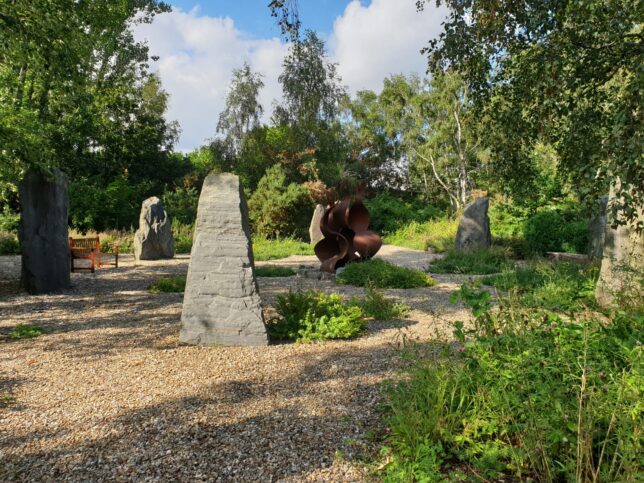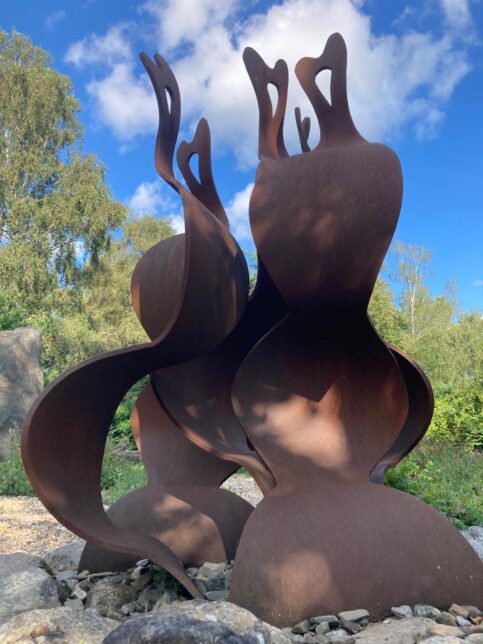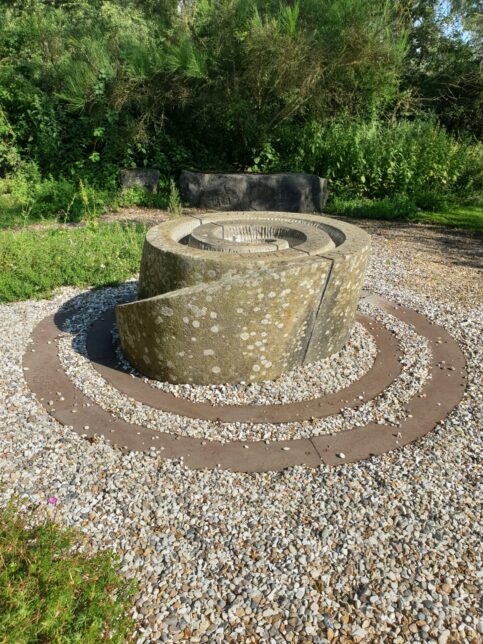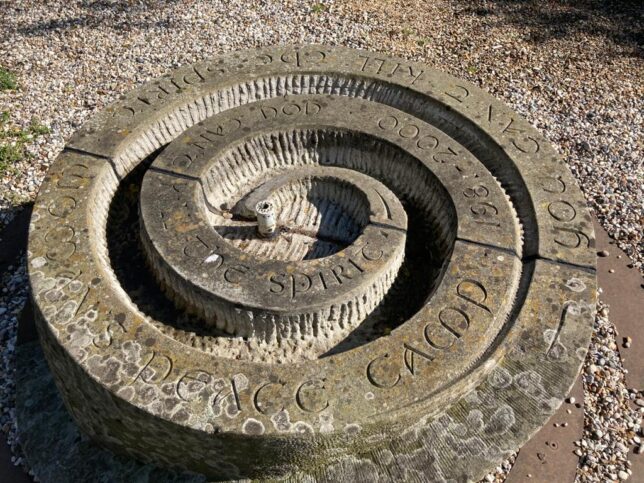Ahead of the “Greenham in Common” event this month, our volunteer Holly introduces the context, some key moments, and the impact of the Greenham Common Women’s Peace Camp, and shares some images from the memorial garden built on its site in 2000.
Activism is crucial for bringing about social, political and environmental change. Women have been and continue to be a vital part of such major shifts that have happened thanks to activism. A prime example of this is the campaigning that occurred at the Greenham Common Women’s Peace Camp.
This year marks the 40th anniversary of the start of the camp. This blog contains some more information about it but if you would like to find out even more, you might be interested in the library’s free event “Greenham in Common” which you can get tickets for here:
https://womenslibrary.org.uk/event/greenham-in-common/
In 1981 a Welsh group of 36 individuals (mostly women) marched from Cardiff to the Greenham military airbase in Berkshire to protest against NATO’s decision to place 96 US cruise missiles there.
Cruise missiles had four times the destructive power of the atomic bomb that obliterated Hiroshima in 1945. Think of this in the context of an escalation in nuclear armament in the UK and Europe and how this would have heightened the fear of nuclear war that was already in existence. Also the fact that these were US missiles that only had a range in Europe led many to believe that the Americans “planned to fight their nuclear war in Europe, devastating our civilisation while leaving their own homeland intact”. (Reference 6)
The group who carried out the 120 mile march were called “Women for Life on Earth” and their initial aim was to have a debate with the government about this potentially devastating decision. Their request for a debate was denied and consequently they set up a Peace Camp just outside the fence surrounding the airbase. This harsh wire fence went on to be the sight of resistance for nearly twenty years.
Greenham was “logically the correct focus of anti-nuclear demonstrations because as the first cruise missile base to become operational, it was politically the most important.” (Reference 6)
Within its first six months it was known as the Women’s Peace Camp and would go on to last nineteen years with mostly women having a presence outside the airbase 24 hours a day.
Even though it was established for so long, life on the camp certainly had its challenges. Living outside during winter and the rainy seasons with no electricity or running water, constant evictions, police brutality and vigilante attacks was very difficult.
However, despite this people came from all over the UK and abroad to stay at the camp and take part in the peaceful protest against nuclear weapons. For many it was “a case of giving up comfort for commitment.” (Reference 2)
The fact that it was an entirely non-violent, peaceful protest gave it “an authority that was hard to dismiss” (Reference 2). As the camp grew, its appearance in the media grew with it. Imaginative and well publicised gatherings meant that the camp and its cause were known nationally and internationally, and consequently the dangers of cruise missiles was a key political issue all through the 80s and 90s.
One of the earliest activist acts was the “Embrace the Base” protest of December 1982. 30,000 women joined hands and formed a chain around the nine mile long perimeter of the fence surrounding the airbase. They tied baby clothes, toys, photographs and ribbons to the fence, an example of how many of the women at Greenham used their roles as mothers or carers to say “this is about the future safety of our children” and how they “weaponised traditional notions of femininity.” (Reference 9)
Another particularly imaginative gathering was in April 1983 when 200 women dressed up as teddy bears to have a picnic in the base. A powerful image: teddy bears against armed soldiers. Whilst this was happening the Campaign for Nuclear Disarmament organised a 14 mile long human chain made up of thousands linking Burghfield, Aldermaston and Greenham (all nuclear sites). Later that year in December, 50,000 women at Greenham encircled the base holding up mirrors to “reflect back the military to themselves.” (Reference 9)
Throughout the protests during the 80s hundreds of women were arrested and some jailed, and many fines were given. The women who stayed at Greenham knew the risks and consequences of their activism but were willing to pay the price to fight for what was right.
All of these actions and countless other examples were a key part in the decision to take away all the cruise missiles from the base in 1991. Other factors did contribute, such as the changing relationship between the Soviet Union and the USA after Gorbachev became the former’s leader. But Gorbachev himself referenced the importance of the Greenham women’s protest in bringing about the removal of the cruise missiles. After this victory in 1991 the camp continued to exist as a place to object to nuclear weapons.
A lovely memorial garden was built on the site after the camp closed in September 2000. It features a flame sculpture (representing the camp fire which was essential for survival and comfort) by Michael Marriott FRBS encircled by seven Standing stones which came from Wales. This is a poignant reference to the march from Cardiff to Greenham Common that started the camp.


In the peace garden you will also find a circular stone and steel water fountain engraved with the words “Women’s Peace Camp 1981-2000” and “You can’t kill the Spirit”.


Many flowers are dotted around the commemorative and historic site such as snowdrops, autumn crocus, wild daffodils and lily of the valley. It is a poetic touch that such beautiful flora can grow on the site where such a struggle to protect life on earth took place.
Here is a list of books in the Glasgow Women’s Library collection about Greenham Common, peaceful activism and denuclearisation if you would like to find out more. At the bottom of the page are also all the links used in this blog.
- The Long Road to Greenham: Feminism and Anti-Militarism in Britain since 1820 by Jill Liddington.
Jill Liddington is a writer and historian whose main research interest lies with women’s history. This book tells the story of the women who marched from Wales to Greenham in 1981, tracking it back through the interwar years, to the Edwardian suffragists and suffragettes, and back to the Female Auxiliary Societies of the 1820s. It won the 1990 Fawcett Book Prize. - Greenham Women Everywhere: Dreams, Ideas and Actions from the Women’s Peace Movement by Alice Cook and Gwyn Kirk.
The Greenham Women’s Peace Camp not only inspired other peace camps around the world, but was also a “cauldron of radical ideas”. (Reference 23) This book details the activities, visions and goals of the women involved in this peace movement. - Reclaim the Earth: Women Speak Out for Life on Earth edited by Léonie Caldecott and Stephanie Leland.
A collection of essays about nuclear proliferation, chemical pollution, land rights, childbirth, ecology and feminist activities around the world. - Pacific Women Speak Out: For Independence and Denuclearisation by Women’s International League for Peace and Freedom, edited by Zohl De Ishtar.
In this book, indigenous women from Australia, Bougainville, East Timor, French Polynesia, Hawaii, West Papua, Marshall Islands, New Zealand and Palau tell their stories of survival and overcoming incredible odds. The editor Zohl De Ishtar says “this book is a contribution to the Hague Appeal for Peace, a global campaign to delegitimise war. It arises from our concern that indigenous Pacific women are rarely heard in the wider international arena and is an attempt to make their wisdom more available.” (Reference 25) In the book we learn of the impacts of invasion and war, nuclear weapons systems, militarisation, human rights abuses, sexism and all the manifestations of colonialism. - Piecing it Together: Feminism and Nonviolence published by Feminism and Nonviolence Study Group in Co-operation with War Resisters’ International.
The War Resisters’ Society is a global network of grassroots antimilitarist and pacifist groups, working together for a world without war. This is a pamphlet written with the belief that many basic ideas are held in common by feminists and by those advocating nonviolence. - On the Perimeter by Caroline Blackwood
In this book Caroline Blackwood depicts the lives, fears and prejudices of all those involved in the Greenham Common Women’s Peace Camp. She visited the camp in March 1984 and in her book she talks to the women themselves, to bystanders, to shopkeepers, and members of RAGE (Ratepayers Against Greenham Encampments). Caroline witnessed the evictions, sexual abuse of the women by the paratroopers and the trials in Newbury of women who entered the base.
These books are reference only and can only be read in the library building:
- Greenham Common: Women at the Wire by Barbara Harford and Sarah Hopkins.
This book is compiled of different women’s accounts of life at the Greenham Women’s Peace Camp. It includes diary entries depicting days such as when the first evictions of the camp took place. - Peace Moves: Nuclear Protest in the 1980s by Ed Barber (photographer), James Cameron and Zoë Fairbairns.
In this book you will find two essays, one written by Zoë Fairbairns and one by James Cameron. It also consists of many photographs taken by Ed Barber. It has been said that Barber’s “straightforward, perceptive black and white documentary photographs exactly captured the mood and actions of those” who protested against the “growing nuclear threat that seemed to hang over the world for much of the late 1970s and 1980s.” (Reference 29) - Breaking the Mould: Edinburgh: Researching and Celebrating 100 Years of Women’s History in Social and Political Activism since the beginning of WW1 published by Workers’ Educational Association Scotland.
The Workers’ Educational Association is the UK’s largest voluntary sector provider of adult education in England and Scotland. It is a charity dedicated to bringing high-quality, professional education into the heart of communities. “Breaking the Mould” has used discussions in workshops, research material and images to shine a light on some of the women and women’s groups, with connections to Edinburgh, who have made a difference in so many areas of life in the 100 years since the beginning of WW1. - Women for Peace published by Women in Black, edited by Staša Zajović.
Staša Zajović is a feminist and peace activist. She is the author of many essays, articles and supplements in local, regional and international media, magazines and publications. She writes about women and politics, reproductive rights, war, nationalism and militarism, women’s resistance to war and anti-militarism. “Women for Peace” is an anthology which includes “the anti-war attitudes and activities of women from the Yugoslav geographical space. It is a record of their emotional conflicts and pain, yet, at the same time, a testimonial of their strength and vitality.” (From the book’s introduction)
To find out more about the Greenham Common Women’s Peace Camp and the lasting impact it has had on activism today, sign up for the library’s free event “Greenham in Common”:
https://womenslibrary.org.uk/event/greenham-in-common/
A big thank you must go out to Nick and Georgia who drove me to the Greenham Memorial Garden and took the photos.
References
1) An article about the march from Cardiff to Greenham that started the camp:
https://www.walesonline.co.uk/news/news-opinion/remembering-women-men-children-who-20124575
2) A webpage about the start and duration of the camp and its effectiveness:
http://www.greenhamwpc.org.uk/
3) This is the same text as the link above, however this one has some colour photographs:
https://happierbeauty.com/blogs/news/history-of-the-greenham-common-protests-1981-2001
4) A webpage providing more details about the commemorative and historic site built where the camp used to be:
http://www.greenhamwpc.org.uk/historic.htm
5) A webpage with more information and photographs of the peace garden built to commemorate the camp:
https://greenhamcommonpeacegarden.org.uk/
6) An article with more information about the cruise missiles and NATO’s plan for more nuclear weapons in Europe:
https://www.theguardian.com/newsroom/story/0,,1865423,00.html
7) A collection of songs written and sung at Greenham by the protestors:
https://www.theguardian.com/yourgreenham/songbook/0,,2071798,00.html
8) More songs from the camp:
https://www.theguardian.com/uk/2006/sep/05/greenham2
9) An article about different women’s experiences and memories of Greenham as well as how it impacted their life today:
https://www.theguardian.com/uk-news/2017/mar/20/greenham-common-nuclear-silos-women-protest-peace-camp
10) A webpage describing the 14 mile human chain in 1983 linking nuclear sites:
http://news.bbc.co.uk/onthisday/hi/dates/stories/april/1/newsid_2520000/2520753.stm
11) A description of archive material available at the Women’s Library in London as well as a history of the Greenham military airbase and the Greenham Women’s Peace Camp:
https://archiveshub.jisc.ac.uk/search/archives/bed612d7-220c-32d9-a7a5-d93001326cdf
12) An article about six other women’s protests that changed history:
https://www.theguardian.com/world/2017/jan/21/womens-march-protests-history-suffragettes-iceland-poland
13) An exploration of the language women use to protest war and whether or not the long tradition of protesting as mothers should be upheld:
https://www.opendemocracy.net/en/5050/women-and-language-of-peace-protest/
14) A blog post about how women’s peace activism can end conflict:
https://blogs.lse.ac.uk/wps/2019/07/22/womens-peace-activism-can-end-conflict/
15) A blog post on the Glasgow Women’s Library website about archive material and items available in the building relating to Greenham Common, as well as diary entries from Pamela Shaw who was a part of the “Embrace the Base” protest that occurred in December 1982:
https://womenslibrary.org.uk/2011/09/21/greenham-common-in-the-archive/
16) An article about the Peace Camp with photographs from the time as well as an image of “The Greenham Factor”, a leaflet published in 1983 to raise funds and awareness which is kept in the Glasgow Women’s Library:
https://guhistfem.wordpress.com/2015/12/18/women-for-peace-the-greenham-womens-peace-camp/
17) A webpage about a feature length documentary due to come out in autumn 2021 about the Greenham Women’s Peace Camp entitled “Mothers of the Revolution”:
https://www.screendaily.com/news/greenham-common-protests-documentary-in-the-works-from-universal-content-group-gfc-films-exclusive/5149056.article
18) A timeline of key events in the camp’s 19 year history:
http://news.bbc.co.uk/1/hi/special_report/1999/11/99/greenham_common/503602.stm
19) A list of books with “Greenham” in the title available at the Feminist Library in London:
https://catalogue.feministlibrary.co.uk/cgi-bin/koha/opac-search.pl?idx=su&q=Greenham+common+&weight_search=1
20) A webpage exploring an exhibition from 2017 about Greenham Common held by Salt Road, a visual artist agency and project space based in the West Midlands that commissions artists and works with partner organisations on social and environmental art programmes across the UK.
Has some photographs from the time:
https://www.saltroad.org.uk/greenham/
21) A list of resources including books, films and webpages about the Greenham Common Women’s Peace Camp:
https://gwynkirk.net/resource-list-gc
22) Jill Liddinton’s website:
http://www.jliddington.org.uk/publications.html
23) A photo of the book “Greenham Women Everywhere”:
https://archive.senatehouselibrary.ac.uk/exhibitions-and-events/exhibitions/writing-protest/greenham-women-everywhere
24) Description of the book “Reclaim the Earth: Women Speak Out for Life on Earth” on amazon:
https://www.amazon.co.uk/Reclaim-Earth-Women-Speak-Life/dp/0704339080
25) A description of the book “Pacific Women Speak Out: For Independence and Denuclearisation”:
https://www.goodreads.com/book/show/6730579-pacific-women-speak-out-for-independence-and-denuclearisation
26) Another description of the above book:
https://www.worldcat.org/title/pacific-women-speak-out-for-independence-and-denuclearisation/oclc/42759204
27) If you are unable to get “Piecing It Together: Feminism and Nonviolence” from the library as it is already checked out, you can read it online here:
https://wri-irg.org/en/story/2010/piecing-it-together-feminism-and-nonviolence
28) A webpage with diary entries taken from the book “Greenham Common: Women at the Wire”:
http://news.bbc.co.uk/1/hi/special_report/1999/11/99/greenham_common/514324.stm
29) A blog post about the work of Ed Barber, the photographer for the book “Peace Moves: Nuclear Protest in the 1980s”:
https://www.letterpressproject.co.uk/inspiring-older-readers/2018-08-31/peace-moves-nuclear-protest-in-the-1980s
30) The “About Us” section of the Worker’s Educational Association’s website:
https://www.wea.org.uk/about-us
31) The Wikipedia entry for Staša Zajović:
https://en.wikipedia.org/wiki/Stanislava_Sta%C5%A1a_Zajovi%C4%87
32) A call from the Guardian for people who were involved with the Greenham Women’s Peace camp to share their memories and photos with them:
https://www.theguardian.com/uk-news/2021/jul/30/share-your-memories-of-the-greenham-common-womens-peace-camp?CMP=Share_AndroidApp_Other

Comments are closed.